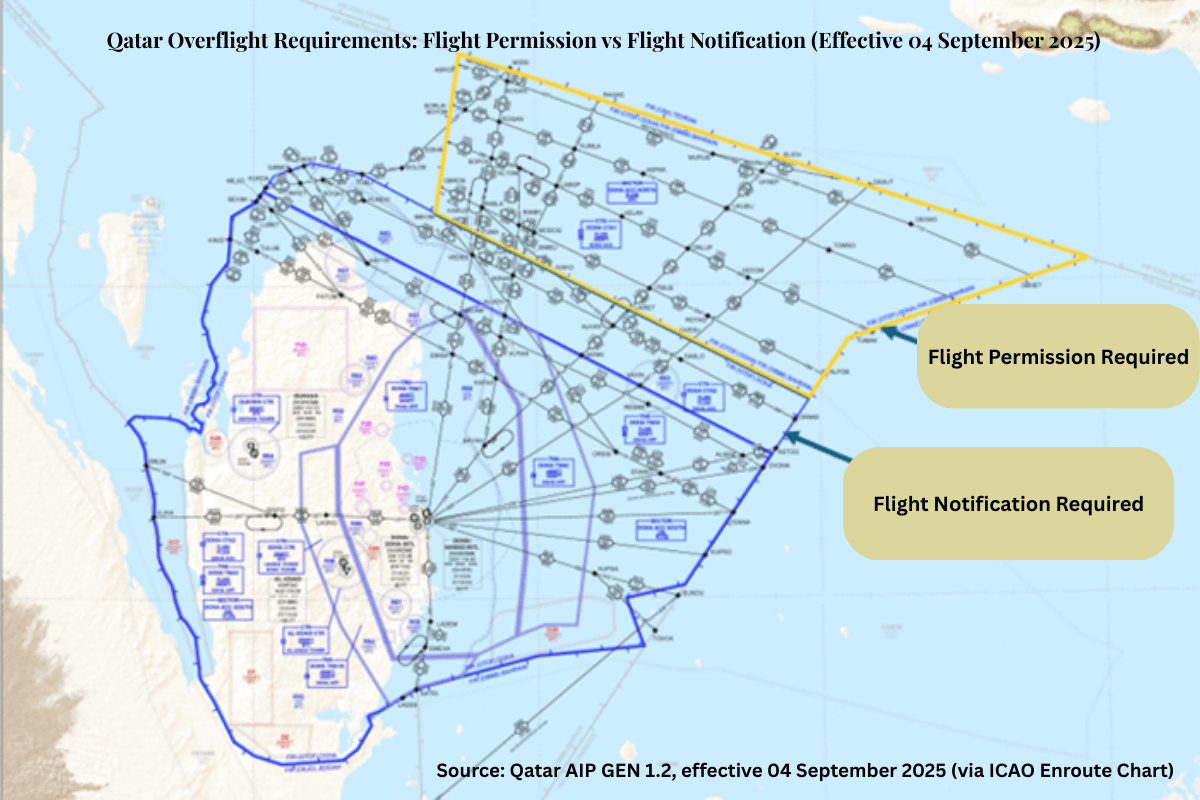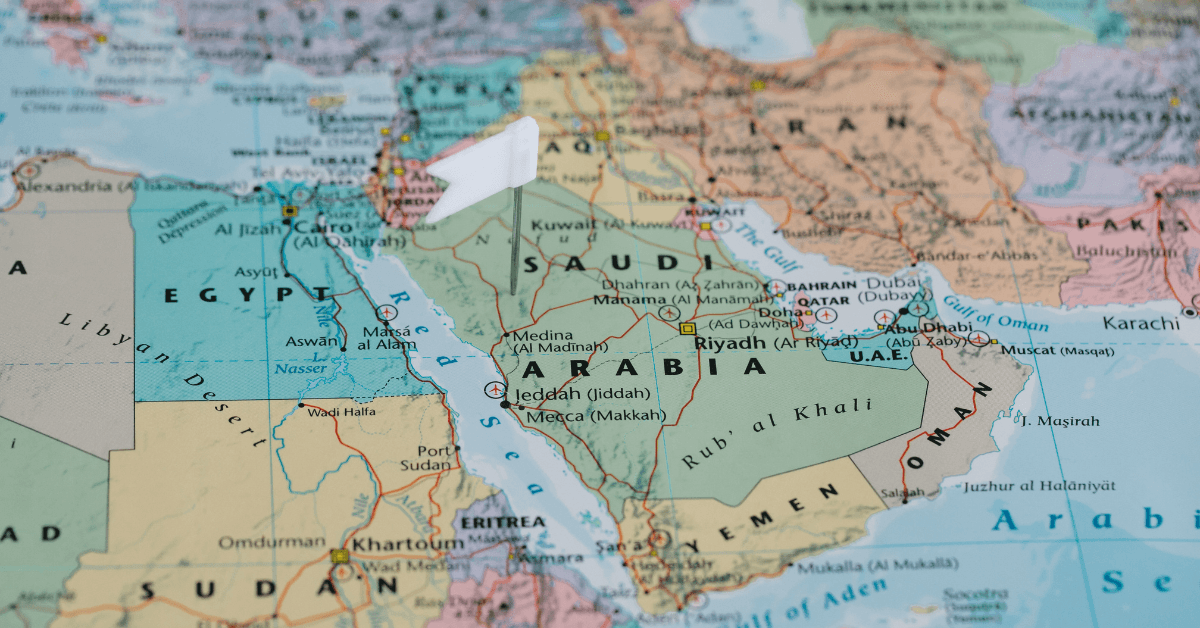Regulatory changes are the norm in global business aviation. The pilots and operations crew who travel over territories have the added responsibility of meeting the requirements of the destination while keeping ahead of overflight prohibition and new procedural changes. The Qatar Aeronautical Information Publication (AIP) saw the introduction of one significant revision in the AIRAC AMDT 05/25, effective September 4, 2025.
Most operators in the past had no obligation at all to issue special notification when they transited the Doha FIR outside the State of Qatar’s territory. The above scenario is now totally opposite. The amendment demands the operators now to issue flight information through the new “Flight Notification” web service whenever they will overfly Doha FIR with no landing in Qatar.
Source: AIP Qatar GEN 1.2, 3.6 (effective September 4, 2025) – Qatar AIP eAIP Portal.
Why Qatar is important to U.S. operators
The Doha FIR is the junction of Europe, Asia, and the Middle East. Many long-haul American private jets headed for India, Southeast Asia, or Africa will usually go through this airspace.
A few examples:
- Routings from New York to Mumbai usually pass through Gulf FIRs, such as Doha.
- Maldives from LAX can involve Qatar FIR transits, depending upon routes determined.
- Traffic from Europe through charter routes often involves working through numerous Middle East FIRs in a string.
Operators so far have only had the experience of obtaining overflight clearances in the case of Saudi Arabia, UAE, Iran, and Iraq – all with prior approval requirements in place. Qatar’s amendment basically puts it in the same position, assuring QCAA visibility and approval of all flights that pass through its FIR.
The new requirement: Flight notification service
The QCAA implemented the required “Flight Notification” protocol, centralized in the same web application as is utilized in application of flight clearances.
Important points from GEN 1.2, section 3.6
Prior Permission: Any unofficial flight that requires overflying Qatar’s territory should be granted prior overflight approval from QCAA at least 48 hours in advance.
This was in effect and remains the same.
New regulation
- For flights only transiting the Doha FIR (outside Qatari territory), operators must now submit a Flight Notification before operations.
- This is not a license per se but is more of a filing.
- Upon application receipt, QCAA will provide an acknowledgment of receipt.
Applications should include:
- Operator name
- Flight number/calls
- Purpose of flight
- Character of the cargo (if any)
- ATS routing (entry-exit points of Doha FIR, FL, and UTC timings)
- Billing Information such as contact and email
Flight plan preparation:
Operators should verify the flight plan (FPL) across ENR 1.10 and ENR 1.11.
Specifically, the operator’s name should be entered under “OPR/” in Item 18 of the ATC flight plan.
Why the change?
Qatari style of regulation may be interpreted in the following context:
- Airspace management: Doha FIR is small but services considerably east-west transit traffic. The new regulation provides the QCAA with better situational awareness.
- Regional harmonization: The immediate neighbors (Saudi Arabia, UAE, Iran) all demand overflight clearances in the FIR or notification. Qatar’s amendment is in accord with regional requirements.
- Security oversight: Extra layers of visibility help QCAA monitor traffic patterns, particularly geopolitical sensitivity in the Gulf region.
Operating considerations for U.S. corporate jet pilots
- Flight planning significance: US operators who are familiar with transiting Qatar FIR without prior coordination will now be obligated to include QCAA notification in their planning checklist. Failure of this step may result in being in non-compliance and refusal of entry into the FIR.
- Lead time considerations: Although the regulation requires in advance permission for Qatari territory flights be submitted no later than 48 hours before the flight, the Flight Notification system doesn’t indicate an absolute lead time. The system should, nevertheless, be considered part of pre-departure planning – certainly not something with which they’d want to wait until final revisions.
- Cooperation with trip support providers: U.S. business jet pilots largely use trip support services like Icarus Jet when requesting Middle East overflight clearances. The new regulation introduces one more check in the box when filing routing requests.
- Billing information: In particular, QCAA requires billing details when filing flight notifications, which is indication that fees will be levied in the future when filing or acknowledging. Pilots should verify with their ops department if fees will be charged.
- Risk of avoidance of FIR
Operators may in principle reroute to avoid Doha FIR, but this may incur time, fuel burn, and overhead. Compliance with the Flight Notification procedure will in general be the most favorable alternative.
Conclusion
Qatar’s adoption of a mandatory Flight Notification system when conducting Doha FIR overflights is a significant procedural step that private jet pilots in the United States should be familiar with. While the regulation is not quite as difficult as the granting of an overflight permit, the procedure is something that crews cannot opt out of.
On long-haul commercial flights from the U.S. to Europe, Africa, and Asia, Doha FIR will remain a standard waypoint. The key to smooth sailing is in the timely filing, accurate flight plans, and vigilant coordination with the dispatch or trip support team.
FAQs
1. Do I need to file a Flight Notification if I’m only transiting Doha FIR and not landing in Qatar?
Yes. As of September 4, 2025, QCAA requires all operators to file flight details through the Flight Notification service for any overflight of Doha FIR, even outside Qatari territory.
2. How is a Flight Notification different from an Overflight Permit?
A permit is required to cross Qatari territory and must be requested at least 48 hours in advance. A Flight Notification applies when crossing only the FIR and involves submitting details for acknowledgment, not formal permission.
3. Where do I submit my Flight Notification?
Through the official QCAA web portal via your trip support partner.
4. What happens if I don’t file a Flight Notification?
Failure to comply may result in denial of entry into Doha FIR or other regulatory consequences from QCAA.5. Are there fees for filing a Flight Notification?
Billing details are required in submissions, which suggests fees could apply. Pilots should confirm with operations teams or QCAA directly.




